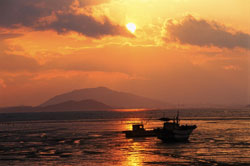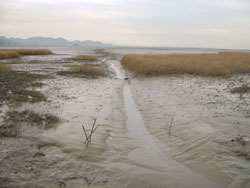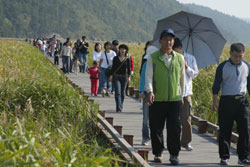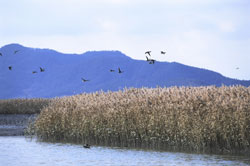
Sunset in Suncheon Bay (Photo: Yonhap news)
The perfect beauty of nature untouched since ancient times always offers humans an endless source of hope and dreams.
In Korea's Suncheonman in Jeollanam-do (Suncheon Bay in South Jeolla Province), people can step back in time by visiting the foreshore and reed fields.
Registered as one of five coastal wetlands protected by the Ramsar Convention in 2006, Suncheon Bay is famous for having the largest reed fields in Korea and also for being on the migration path of various kinds of rare birds from throughout world.
These days, the bay is also busy getting ready to welcome 2,000 wetland experts from 165 countries during the upcoming meeting of the Ramsar Convention, scheduled to take place from Oct. 28 to Nov. 4.

Wetland in Suncheon Bay (Photo: Yonhap news)
The 21 square kilometer-wide costal wetland is filled with reeds that create golden waves when the wind blows, turning anyone who sets foot in the area into a poet. The shifting sunlight constantly creates different hues over the field every moment in each of the four seasons.
To amuse visitors during the Ramsar Convention period from Oct. 28 to Nov. 4, the Suncheon Bay Reeds Festival will be held at Suncheon Ecological Park, located inside Suncheon Ecology Museum. More information about the festival is available on 061-749-3328/3742. Visitors who love to be out at night can also have fun at the Suncheon Observatory, which will be open to the public from October, to show off the beauty of the starry nights.

Visitors walk along the field of reeds in Suncheon Bay. (Photo: Yonhap news)
Visitors can look around the costal beauty of the bay on the ferryboat from Daedae port in the evening around sunset. After getting off the boat, travelers can also walk along the reed fields for about 40 minutes and find a low mountain named Yongsan (mountain).
According to folktales, a dragon wanted go to heaven but decided to come back to earth after being captivated by the beauty of the bay. A lookout located on the mountain is the only vantage point that helps visitors find the beauty of the bay with its picturesque view. The thousands-of-years-old wetland and its river run towards the sea, creating heavenly S-shaped curves and peaceful a scenery of harmony between nature and humans.

Migratory birds in Suncheon Bay (Photo: Yonhap news)
Visitors need to get on the boat again to see the foreshore of the bay, where you can explore the mystery of the ecosystem in the mud. Those who want to know more about the beach can also join the "Beach Experience Course in Jangsan." It is designed to help people understand Suncheon Bay and the ecosystem on the beach. In fall, a scarecrow festival and reed festival are held here.
The variety of beach life attracts many rare kinds of birds, making the foreshore the birds' haven. In late October, visitors can see hooded cranes migrating from Russia and some 200 kinds of birds, almost half of all the kinds of birds we can see in Korea.
To see other attractions after visiting the bay, go to Songgwangsa, one of the three biggest temples in Korea. The temple has wooden national treasures, including wooden Buddhist scriptures. The harmonic sound of the temple's bell will clear the mind of anyone entering this place in the quiet mountain. Visitors can also join the temple stay program to experience the life of a Buddhist monk. The temple stay program also includes a tour of Suncheon.
For more information about Suncheon Bay and related eco tours, click here or call 061-749-3328/3742. More information is also available at 02-1330, with interpreting services available around the clock.
By Yoon Sojung
Korea.net Staff Writer